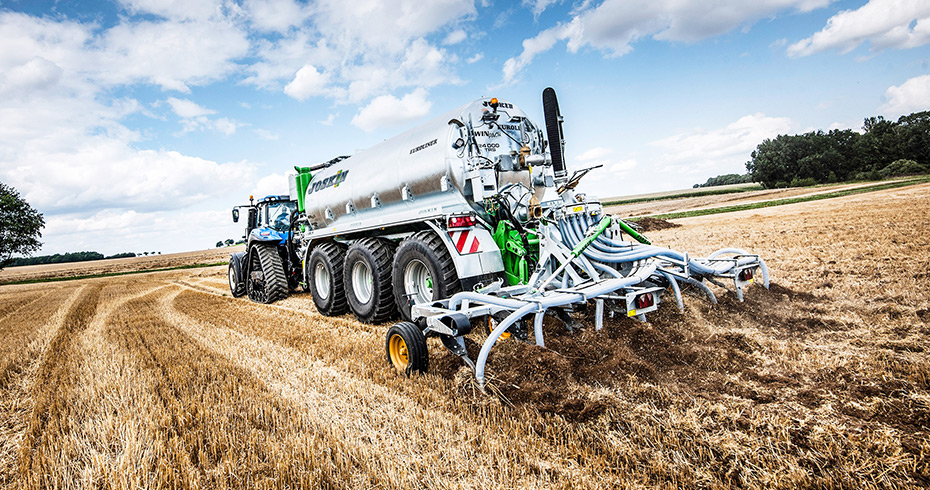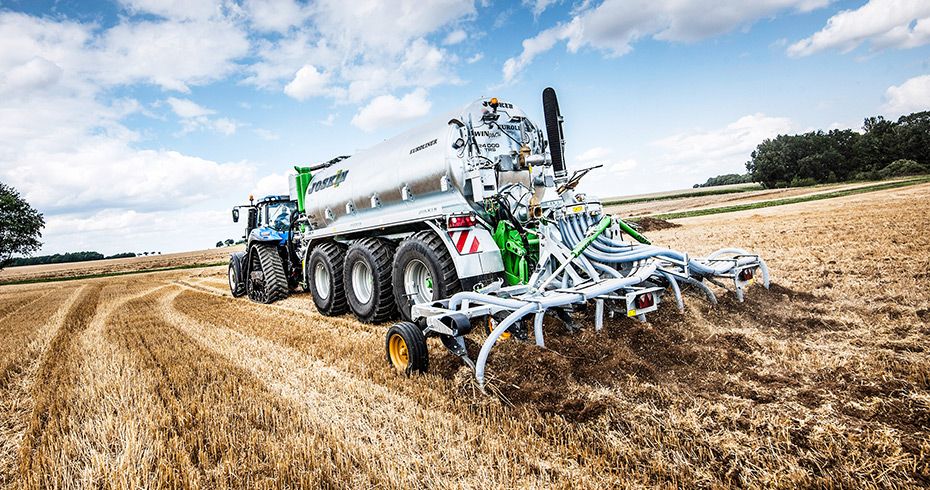Previously considered a common waste, slurry has gradually acquired the status of brown gold among farmers. And with good reason: it is a rich and abundant natural resource, with an incredible fertilising potential allowing to increase the yield of meadows and crops at a limited cost. Its spreading, however, requires the use of a suitable equipment that can preserve the natural properties of slurry (organic matter, nitrogen, phosphorus, lye, magnesium, etc.) to the maximum while distributing them evenly. Among the existing solutions, several succeed in combining efficiency, profitability and ecology. A brief overview...
It is no secret anymore that in order to spread successfully, the good quantity of the appropriate fertiliser must be spread at the right time and place. However, it can only happen with an appropriate implement. Within the frame of an ever-strengthening legislation, this criterion is not optional anymore, but rather compulsory. Spreading is not trivial. If slurry is not properly spread, high quantities of ammonia can be released, both in the hours and days following the spreading. These ammonia losses are not without consequences. Next to environmental damage, they are also the main cause of unpleasant odours, which are often not very well accepted by neighbours. These losses also have financial consequences. The extra costs resulting from the purchase of mineral nitrogen fertilisers, which aim at compensating losses, are indeed far from insignificant. This shortfall can indeed reach thousands of euros for a medium-sized farm.
For a long time, scatterers were the most common spreading system. They were rather basic and were only spreading the slurry as a layer on the surface of the soil; which led to a great lack of precision and homogeneity and dirtied the vegetation (and therefore the silage) in the process. The slurry was also highly in contact with the air. As it decomposed into fine drops, it very quickly lost its gaseous components, which were released into the atmosphere and caused at the same time significant odour emissions. In some cases, it was therefore not uncommon to see a 100% loss of nitrogen!
As a recognised and experienced player on the market of rear implements, JOSKIN understood the real potential of slurry quite a long time ago and tried to improve the spreading techniques very early. For more than 30 years, JOSKIN has been acquiring a significant technical advance in the development of spreading implements and offers a complete range of them that foster a profitable, durable and responsible agriculture. Within this range of products, two main families can be distinguished: spreading booms and injection implements. Let us analyse their specifications in detail...
Spreading Booms
The emergence of spreading booms was a major revolution in the agricultural world. Thanks to their large width, they make it possible to spread slurry more quickly over large areas. By applying it as close as possible to its target, they avoid splitting it and also reduce its contact with the air. They therefore guarantee a significant reduction in ammonia losses through volatilisation. The efficiency of the nitrogen is then considerably increased and the odour nuisance is significantly reduced.
The operations also become more precise and homogeneous. With a boom, the spreading lines remain precise and regular, regardless of the wind conditions. The slurry is distributed from pipes with a regular line spacing (25-30 cm) over the entire width of the implement. In order to guarantee the homogeneity of this distribution and to avoid the clogging of some pipes, these booms are equipped with one or more macerator(s). Thanks to a system of self-sharpening circular blades fitted on blade holders, the macerators improve the flow of highly fibrous slurry, but also systematically cut all the foreign material it may contain.
There are two main types of spreading booms, depending on their use. First of all, there are those with line hoses. They are of considerable agronomic interest: thanks to their flexible hoses that run at ground level, they apply the fertiliser directly at the foot of the plant without slowing down its growth. Only a small part of the grass is soiled by the slurry. These characteristics make these booms particularly suitable for fertilising crops, but also meadows. Although the slurry remains on the soil surface, it is estimated that the resulting reduction in air contact reduces volatile losses by more than 35%.
Next to these models are the so-called spreading booms “with skids”. Based on a similar structure, they are additionally equipped with skids that exert a constant pressure on the ground by means of a system of spring leaves. By moving apart the vegetation, these skids ensure a precise distribution of the nutrients close to the plant base without dirtying the leaves or fodder. These implements are therefore ideal to fertilise meadows. Here again, although the slurry remains on the surface, their permanent contact with the soil ensures a significantly higher reduction in grass soiling as well as a reduction of about 50% in volatile losses. It should also be noted that these booms, due to their specific features, can also be used later, when the grass is taller and the foliage more developed. In fact, thanks to the stiffening of the line hoses by means of metal blades that prevent them from bouncing off the stems, coupled with the presence of skids, they effectively spread the grass without flattening it and then apply the slurry precisely at the base of the plant. The fertiliser thus remains covered by the foliage, which partially shelters it from the wind and the sun, while keeping it in a more humid and cooler environment. Emissions into the atmosphere are therefore diminished.
Injectors
Alongside these booms, there is another category of implements: the injectors. As their name implies, they inject the slurry directly into the soil. In this way, they ensure that the fertiliser is delivered where the plants get the nutrients they need to grow, i.e. at their roots. Ammonia losses and odour emissions are thus reduced to a minimum and in some cases even become non-existent. Injectors are therefore the optimal solution in terms of efficiency, cost-effectiveness and environmental friendliness.
Depending on their use, there are two categories of injectors. First of all, there are the ones for meadows. Their working principle has a clear objective: to fertilise the first layer of soil while preserving the present plant cover. To fulfill this role, they include free-steering elements designed to maintain a permanent contact with the ground, regardless of any irregularities encountered, while exerting a constant pressure so that their tools can cut the soil. These tools can be of two types: cutting discs or conical discs. The former have a maximum working depth of 3 cm. Arranged at regular intervals in order to ensure an optimum cross-distribution, they cut the grass and make a slight groove in the ground. The slurry is then applied in the heart of this groove by means of injection cones preceded by skids in order to guarantee a precise application, without splashing the vegetation. Only the base of the plant is lightly soiled over a small width. Approximately 85% of volatile losses and odours can in this way be avoided.
Based on the same process, injectors with conical discs allow a deeper injection of the slurry (usually 6 cm, depending on the adjustment and pressure on the discs) while guaranteeing a faster penetration at the root: the discs first make a groove in which the injection cones then apply the fertiliser homogeneously without soiling the vegetation. As it is below the soil surface, the slurry is absorbed more quickly by the roots and ensures a higher and faster yield from the vegetation. This injection into the soil also prevents the release of more than 95% of odours and ammonia losses into the atmosphere, while reducing the risk of slurry leaching by unexpected rainfall. It should also be pointed out that, depending on the adjustment made on the machine, it will also be possible to use this type of injector for surface work (with less pressure on the ground) on taller grass. In this case, the discs will act as a grass spreader, allowing the injection cones to apply the slurry cleanly at the base of the vegetation. The fertiliser thus remains covered by the foliage and sheltered from the wind and the sun, while being kept in a more humid and cooler environment.
The second category of injectors consists of the arable models. They are designed to create the most favourable conditions for growing crops. To that end, they fulfill a double function: they carry out a complete stubble ploughing while simultaneously burying the slurry in the soil. Most often used before sowing, these injectors apply the fertiliser as close as possible to the plant. The slurry is mixed with the soil and spread over the first few centimetres below the soil surface. The nutrients are therefore brought directly to the sowing area, where the plant will generate its first roots, thereby ensuring a fast growth. Since all the slurry comes below the soil surface, there is no ammonia loss, no odour pollution and no risk of leaching.
Depending on the type of soil encountered or the work required, these injectors will be equipped either with rigid tines, spring tines or discs. The models with tines can work up to 15 cm deep. Rigid tines are more suitable for sandy soils, while spring tines are preferred for heavier or stony soils. During the work, these tines first open the ground while the injection cones located immediately behind apply the slurry, thus guaranteeing an excellent loosening work, while keeping the injection depth chosen by the farmer constant.
Next to these models with tines, the disc injectors offer a different action: equipped with 2 rows of curved and toothed discs, they work up to max. 10 cm deep. Their first row opens the ground, creating a groove in which the injection cones placed next to the discs apply the slurry. The second one, whose elements are positioned in the opposite direction as those of the first one, cover up and bury the slurry. Although these models require more power, they guarantee an even more homogeneous mixing of the fertiliser and earth.
Just like these implements, a wide range of machines is now available to farmers. While on the one hand regulations are becoming stricter to encourage an ever more sustainable and environmentally friendly agriculture, technological advances on the other hand show that this is the right direction to take. By increasingly managing to preserve the fertilising properties of slurry, the latest generation of implements considerably reduces the cost for purchasing additional mineral fertilisers. As a result, the machinery keeps providing ever-shorter returns on investment. There is therefore no longer any reason not to take the plunge; let us make the most of our manure!


